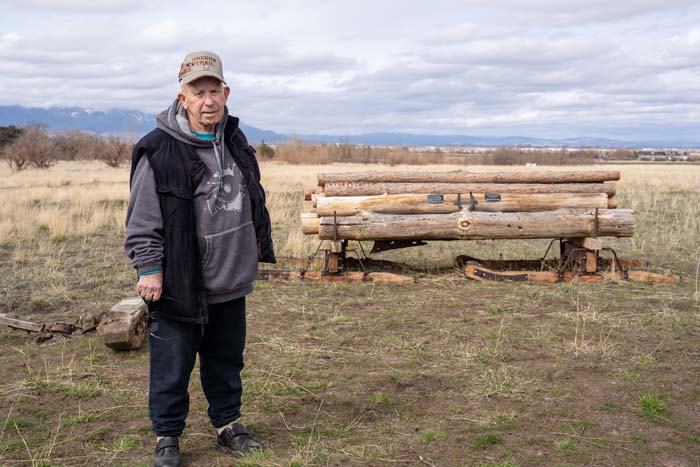Oregon Trail interpretive site near Hot Lake receives noteworthy additions
Published 9:00 am Saturday, March 26, 2022

- Ronnie Allen poses for a photo March 21, 2022, near a newly restored logging sled at an Oregon Trail site in Lower Ladd Canyon south of La Grande. Allen and Dale Counsell, both of La Grande, created the interpretive site and continued adding to it.
LA GRANDE — Four years ago, Dale Counsell and his son, Scott, found an unforgettable link, not to an internet website but to an era when digital technology was still the stuff of science fiction.
The Counsells were in Ladd Canyon on their family’s ranching land when Scott Counsell spotted a metal chain link sticking up from the ground and told his father. Curious, the Counsells began digging. What they found was not precious metal but something to treasure, a horse-drawn logging sled Dale Counsell said was used by a family who had owned the land as homesteaders in the late 1800s.
Nobody knows how long the sled had been buried but it was obvious the time underground had taken its toll.
“It was in terrible shape,” Dale Counsell said.
A skilled craftsman who loves history, Dale Counsell then refurbished the sled by replacing its wood while retaining its metal elements. Today, the sled is on public display as one of the latest additions to an Oregon Trail interpretive site on Hot Lake Lane, 2 miles west of the Lodge at Hot Lake Springs. The sled is loaded with logs from tree species common to Union County — white fir, lodgepole pine and tamarack, also known as western larch.
“The job Dale did restoring that sled is incredible,” said Ronnie Allen, of La Grande, who with Dale Counsell created the Lower Ladd Canyon Oregon Trail site five years ago.
The interpretive site is about a mile from the base of Lower Ladd Canyon Hill. Allen said Oregon Trail pioneers came off the hill directly to where the interpretive site is located.
In the mid-1800s, Oregon Trail pioneers made overnight stops at the location, he said. Allen estimates that from 1843 through the early 1860s, between one and five wagons were at the site continuously during the summer months.
The sled now at the site was likely used not only to transport trees but also hay, supplies and people, Counsell said.
The logging sled is one of several significant additions made to the Oregon Trail site over the past month. Other additions include an ox yoke, donated by Craig’s Antiques, of La Grande, that was used by oxen to pull a wagon across the Oregon Trail, Allen said.
“It shows heavy wear consistent with pulling covered wagons over the Oregon Trail,” he said.
Yokes, like the one displayed, were wooden beams normally used between a pair of oxen to enable them to pull together on a load when working in pairs.
Oxen are regarded as the unheralded heroes of the Oregon Trail, Allen said. He noted that the vast majority of the pioneers coming West on the Oregon Trail used oxen instead of horses. Pioneers preferred them because they are calmer and easier to work with than horses.
“They are not as temperamental as horses,” Allen said.
Pioneers took excellent care of their oxen, Allen said, because they knew that without the animals, they would be in dire circumstances.
Oxen sometimes drank water from wooden buckets on the Oregon Trail when they could not be taken to streams or springs. The buckets pioneers used to bring water to their oxen were virtually identical to a bucket that was also recently added to the Oregon Trail interpretive site, Allen said.
It is easy for visitors to the site to get a feel for the type of wagon oxen pulled across the West for it has two replicas of them. Both are farm wagons more than 100 years old that are like those used on the Oregon Trail. Allen said farm wagons started being used on the Oregon Trail due to a shortage of the more popular Conestoga wagons.
No actual wagons in which pioneers traveled across the Oregon Trail still exist, Allen said. He explained by the time pioneers made it to Oregon, most wagons were in terrible condition. Those that were functional were used for farm work until they worn out. And after about five years of farm work, he said, “they were useless.”
Allen, who received a Distinguished Service Award in 2019 from the Northwest chapter of the Oregon-California Trails Association for his work in helping create the Oregon Trail interpretive site in Lower Ladd Canyon, said there will be more additions to the center in the future.
“It is an ongoing project,” he said. “There really will be no end to it.”





